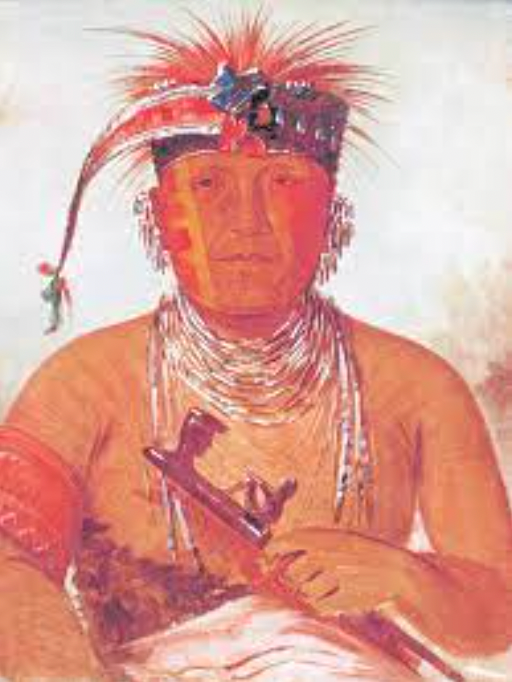Historical Context
 Image Courtesy: kawnation.com
Image Courtesy: kawnation.com
For a detailed timeline of Kanza history, visit the Kaw Nation’s Timeline on their website.
The information below is intended as a summary to contextualize this Chapman Center for Rural Studies project.
15th Century and before
The Kanza peoples are of the larger language and cultural group of the Dhegian-Siouan peoples (also including the Osage, Ponca, Omaha, and Quapaw). Kanza homelands are west of the Mississippi including the Tallgrass Prairie and Great Plains region.1673 European Colonization
Père Jacques Marquette travels down the Mississippi River, mapping the land and people of the region for France. While Marquette did not interact with the Kanza, this map is evidence that Europeans were aware of the Kanza nation. From a legal perspective, maps like these were also sometimes used to establish “Right of Discovery” for the French, which Europeans used to rationalize colonization and seizure of lands occupied by sovereign nations.
1776-1783 The American Revolutionary War
This war leads to the establishment of an independent U.S. government. The new U.S. government adopted European approaches to colonialism, including the Doctrine of Discovery, which, by the 1830s, became the legal backbone for continued colonization, known as “Manifest Destiny.” This was affirmed in U.S. case law in a series of three Supreme Court cases that would come to be known as the Marshall Trilogy: Johnson v M’Intosh (1823), Cherokee Nation v Georgia (1831), and Worcester v Georgia (1831).1803 Louisiana Purchase
The U.S. bought from France the Right of Discovery to Kanza and other Indigenous nations lands in the center of the continent. This was done without the knowledge or consent of these Indigenous peoples. The sale gave the U.S. the exclusive right to purchase these lands from Indigenous nations under the Doctrine of Discovery.1804 Lewis and Clark Expedition
This expedition marked the beginning of U.S. colonial incursions into the West. While the Spanish had settlements in the areas that would come to be known as New Mexico and California since 1598 and 1769 respectively, the U.S. government-funded exploration of the West by the Lewis and Clark expedition set the stage for land speculation and non-Native settlement in the Great Plains. Clark would go on to become general of the militia and superintendent of Indian affairs in St. Louis, negotiating land cession treaties in the areas he formerly explored. Notably, Clark had mixed feelings about these treaties. With respect to the Osage Treaty of 1810 (also known as the Treaty of Ft. Clark), it was reported that he said, “If he were to be damned hereafter it would be for making that treaty” (qtd. in Edwards 64-65).1821
Missouri obtained statehood and the Santa Fe Trail opened. From 1821 to 1880, the Santa Fe Trail was a major trading route that extended from Missouri to Santa Fe, New Mexico. U.S. government officials often framed treaties as ways to ensure that such trade could continue uninterrupted.This trail bisected the Kanza homelands paving the way for more non-Native settlement to the area and leading to an influx of squatters on Kanza land as well as to the overhunting of bison, overgrazing of grasslands, and disruption of traditional hunting patterns of the Kanza. This pattern is part of the larger story of food deprivation and colonial encroachment that allowed the U.S. to seize land and power.Treaty of 1825
The fact that the Kanza people’s first treaty of land cession with the U.S. followed the opening of the Santa Fe trail by four years was no coincidence. As non-Native people moved to and through this region from the Eastern U.S., more became interested in settling on the rich grasslands of the Kanza homelands. The Treaty of 1825 diminished the Kanza’s 20 million acre territory to a 2 million acre, thirty–mile-wide reservation, opening 18 million acres for speculation and settlement by certain U.S. citizens. See the Treaty of 1825 annotations for specifics about this history.
1830 Indian Removal Act
U.S. Congress passed this legislation, which facilitated the expulsion of Indigenous nations east of the Mississippi River into land west of the river. However, this “removal” constituted an invasion of eastern Indigenous people into Kanza homelands. During this era, the modern states of Nebraska, Kansas, and Oklahoma were designated “Indian Territory” and many Indigenous nations were confined to reservations in this region.Treaty of 1846
This treaty reduced the 2 million acre reserve to 256,000 acres including present-day Council Grove, Kansas, which became an important hub on the Santa Fe Trail. Notably, while the U.S. government recognized this land as belonging to the Kanza, U.S. settlers illegally established farms and squatted on these lands, reporting in correspondence and local newspapers that they were confident that the federal government would back their claims, which, in the end, was true.1853 Indian Appropriations Bill
U.S. Congress passed an Indian appropriations bill that authorized the president to reduce Indigenous land holdings in what is now known as Kansas in order to facilitate non-Native settlement in the region. This encouraged non-Native squatting on Indigenous reservations, including Kanza land.1854 Kansas Nebraska Act
This act of U.S. Congress was intended to facilitate railroad expansion through the Louisiana Purchase to the newly acquired lands from the Mexican-American war, namely California. This created two new territories, Kansas and Nebraska, which encouraged even more U.S. settlement. However, the federal government had not negotiated any new treaties with Indigenous nations and therefore non-Natives squatted on Indigenous lands, including the Kanza reservation, as they moved into Kansas territory.Treaty of 1859
This treaty further reduced the Kanza reservation to only 80,620 acres, where each family retained 40 acre allotments. The 175,000 acres acquisitioned by the U.S. was sold to non-Natives in 160-acre parcels, demonstrating that a 40-acre piece would likely be too small for support a Kanza family, perpetuating cycles of debt, starvation, and illness. Furthermore, the U.S. government practice of allotment not only allowed the U.S. to take more land but also enforced a model of individual land ownership onto the Kanza people that assaulted their cultural traditions and communal land use practices.
1861
On January 29, Kansas obtained statehood and on April 12, the U.S. Civil War began.1862 Morrill Act
This act was passed by U.S. Congress and signed into law by President Abraham Lincoln. The legislation redistributed Indigenous land to support the growth of higher education in the U.S. Reselling these lands for profit brought significant amounts of money to the universities (and their endowments) that received these land grants. See the linked map for a visual representation of the land allocations.1865
On April 9, the Civil War ended with reunification of the United States and marked the beginning of a newly consolidated and powerful nation.1866
Following the end of the Civil War, railroads rapidly expanded into and through Kansas. Corporate speculators vied with non-Native settlers to seize Indigenous homelands. Pressure on the federal government to acquire more Indigenous land also grew as more people traveled the Santa Fe Trail and Kansas settler squatting on Indigenous land expanded.1871
Historically, treaties with Indigenous nations, though coercively negotiated, were approved (ratified by) the U.S. Senate. However, the House of Representatives wanted increased power in acquiring land. To make this a reality, the U.S. officially ended its policy of formal treaty negotiations with Indigenous nations through a congressional resolution. There was no Indigenous consultation on this decision, which was hurriedly “tacked on to the Indian Appropriations bill of 1871” (Hirsch, “1871: The End of Indian Treaty-Making”). While previous treaties were still recognized as valid, Indigenous nations were no longer treated as relative sovereigns until the Indian Reorganization Act of 1934.
1872
In the absence of treaties, U.S. Congress was now able to unilaterally make decisions on subsequent land acquisitions. Thus, the last Kanza land cession in Kansas was the result, not of a treaty, but of congressional action: House Report Number 2503 required the appraisal and sale of the Kanza’s remaining land and expulsion from their homelands. Pushed by railroad and mining speculators and ever-increasing pressure from non-Native settlers who knew they were squatting illegally on Kanza land, Congress passed the “Kaw Land Bill”. This bill removed the Kanza to Indian Territory (present-day Oklahoma) and re-sold their land in 160-acre tracts to non-Natives. There was strong dissent from the Kanza to the seizure and sale of their land. As Chief Allegawaho stated in 1871, “The whites have made attempts to buy my land, but I have refused to listen to them” (qtd. in Parks 232).1873
Despite multiple vehement protests, the remaining 553 Kanza were forced to leave Kansas on June 4, 1873 for a 100,000-acre reservation south of the Kansas state-line in present day Kay County, Oklahoma. This act officially expelled the Kanza from the state that bears their name.1902
On July 1, the U.S. Congress passed the Kaw Allotment Act, which “legally obliterated the tribe,” retaining only 260 acres of their Oklahoma reservation as trust land and moving the rest of their lands into individual ownership. The U.S. government allotted some of this land to Kanza people and the remaining “surplus” land was reallocated to non-Natives.1934 Indian Reorganization Act (Wheeler-Howard Act)
Also known as “The Indian New Deal,” the U.S. Congress passed the Indian Reorganization Act (IRA) put in place legal mechanisms to promote federal reorganization of tribal nations. Reorganization was intended to help restore some aspects of self-governance among Indigenous nations.1959
Federal reorganization of the Kaw Nation under the Indian Reorganization Act occurred. The Kaw Tribal Council that had been stripped of its power in 1902 through the Kaw Allotment Act, regained some independent authority.
1960-1970
Washunga, the Kaw Nation home in Oklahoma, which was promised to the Kaw in perpetuity, or for all time, was seized by the U.S. government via eminent domain. In yet another forced removal, the Kaw were compelled to leave the old town of Washunga, including the Kaw Tribal Council House and cemetery. This land was subsequently flooded by the U.S. Army Corp of Engineers to create Kaw Lake, a reservoir and recreation area. While the U.S. government had promised the Kaw Nation that they would appropriately move human remains from cemeteries, this was later found to be false, amounting to grave desecration (kawnation.com).1990
The first Kaw constitution was adopted.1992
The Kaw National Tribal Court was founded.2000
Kaw Nation purchased land around the Unknown Indian Monument near Council Grove, Kansas. Known today as Allegawaho Heritage Memorial Park, this constitutes a return of Kanza sovereignty within their homeland. This land was a portion of their 1845 reservation and includes remnants of the Kaw Agency and other stone buildings erected by the federal government.2021
The Kaw Nation successfully petitioned Douglas County and the City of Lawrence to have In ́zhúje ́waxóbe, a Kaw sacred boulder, repatriated, or returned to Kaw Nation stewardship. In ́zhúje ́waxóbe was seized by settlers and moved to Robinson Park in Lawrence, Kansas as a “monument to pioneers” in 1929. For more information see grant project websites associated with this work:robinsonpark1929.com and sacredredrock.com.2022
Today, the Kaw Nation numbers more than 3,600 citizens.
The preceding timeline, introduction, and the subsequent treaty annotations employ a number of sources, key resources include: the official Kaw Nation website; the Southern Plains Tribal Health Board website; Ronald D. Parks’ The Darkest Period: The Kanza Indians and Their Last Homeland, 1846-1873; Tai S. Edwards’s Osage Women and Empire: Gender and Power; Robert Miller’s Native America, Discovered and Conquered: Thomas Jefferson, Lewis and Clark, and Manifest Destiny; and William E. Unrau’s The Kansa Indians: A History of the Wind People, 1673-1873 and Mixed-bloods and Tribal Dissolution: Charles Curtis and the Quest for Indian Identity; and Craig Miner and William E. Unrau’s, The End of Indian Kansas: A Study of Cultural Revolution, 1854-1871.
![]()
Partial funding for this program is provided by Humanities Kansas, a nonprofit cultural organization connecting communities with history, traditions, and ideas to strengthen civic life, as well as the College of Arts and Sciences at Kansas State University and the Kansas Studies Institute at the Johnson County Community College.
The findings, conclusions, etc., are not necessarily those of HK or the National Endowment for the Humanities.

